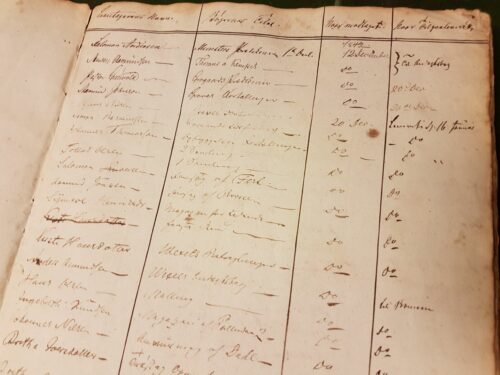Library circulation ledger from St. Jørgen’s Hospital
For a period, there was a small library for the residents at St. Jørgen’s hospital, and a circulation ledger has been preserved for a ten-year period from 1843. It is the only library record from the hospital that has been preserved. This may have been the only period there was a library for the residents, although this is not known.
In 1845, the library had 65 volumes. There appear to have been fixed lending days, usually once a month or every other month. The ledger shows that the residents did use the library. On 16 January 1844, for example, as many as 52 residents each borrowed a book. Hospital chaplain Grønvold was one of the first to borrow a book, ‘Grøgaard’s Sermons’, from the library. Perhaps he was preparing for one of his sermons.
Unfortunately, only the first pages of the ledger show which books the residents borrowed, after which only the book numbers are noted. We don’t have records showing the books’ corresponding numbers in the library. The books listed include titles such as ‘Graves Tales’, ‘Wexels’ Reflections’, ‘Reading book for children’ and ‘Constructive Stories’.
‘Grave’s tales’ is parish pastor Immanuel Grave’s ‘National tales for the Norwegian peasantry’, a book of good stories for entertaining and educating the peasantry. ‘Wexels’ Reflections’ is presumably Wilhelm Andreas Wexsels’ ‘Christian Reflections with Corresponding Psalms. Published to be used for Home Devotion’. The reading book for children is perhaps ‘Reading Book for Children’ by Hans Jacob Grøgaard, who was the parish pastor in Nykirken i Bergen from 1822. It was first published in 1815 and later as a revised and expanded edition in Bergen in 1824, ‘Reading Book for Children, a Preparation for Religious Education, especially in Norwegian school districts’.
Among the books listed in the ledger, there appear to be many religious books, which was not uncommon at that time. The religious aspect of life in the hospital was also very important. The residents were expected to be devout, and they put their hope in a better life after death.

Photo: Ingfrid Bækken, Bergen City Archives. Detail.

Photo: Ingfrid Bækken, Bergen City Archives.

Photo: Ingfrid Bækken, Bergen City Archives.



